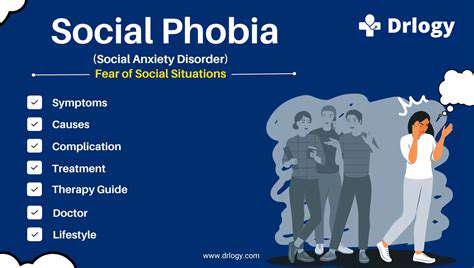Different Anxiety Disorders Explained: A Comprehensive Guide
Understanding Generalized Anxiety Disorder
Generalized Anxiety Disorder (GAD) involves persistent and excessive worry about various aspects of daily life. Unlike typical anxiety, this condition isn't tied to specific events, making it particularly challenging to manage. Those affected often anticipate negative outcomes even without clear reasons, significantly impacting their well-being and daily activities.
It's crucial to differentiate GAD from normal worry. While occasional concern is universal, GAD creates debilitating anxiety that disrupts relaxation, focus, and decision-making.
Symptoms of GAD
Identifying GAD symptoms early is key to effective treatment. Common signs include relentless worry, restlessness, fatigue, trouble concentrating, irritability, muscle tension, and sleep issues. These symptoms fluctuate but consistently hinder personal and professional life.
Physical manifestations like headaches, stomach problems, and trembling further illustrate GAD's pervasive nature.
Causes of GAD
The exact origins of GAD remain unclear, but genetics, environment, and learned behaviors likely contribute. Research indicates a hereditary component, with higher risks for those with family anxiety histories. Childhood adversity, major stressors, and certain personality traits also play roles.
Recognizing these factors helps tailor effective coping strategies and treatments.
Diagnosis and Assessment
Diagnosing GAD requires a mental health professional's comprehensive evaluation. This includes reviewing symptom history, duration, intensity, and life impact. Physical exams may rule out medical conditions mimicking anxiety.
A thorough assessment ensures personalized treatment plans.
Treatment Options for GAD
Multiple treatments exist for GAD. Cognitive-behavioral therapy (CBT) is particularly effective, helping patients reframe negative thoughts and adopt healthier coping methods.
Medications like SSRIs can alleviate symptoms, sometimes combined with therapy for optimal results. Lifestyle adjustments—exercise, balanced nutrition, and adequate sleep—also significantly improve outcomes.
Coping Strategies for GAD
Effective coping is vital for managing GAD. Techniques like mindfulness, deep breathing, and progressive muscle relaxation calm the nervous system.
Time management, task prioritization, and realistic goal-setting reduce overwhelm and restore control.
Living with GAD
While GAD poses challenges, it's manageable with proper support and strategies. Building a network of friends, family, and professionals fosters resilience.
Self-care and support systems are foundational for navigating GAD's complexities.
Panic Disorder: Sudden and Intense Fear

Understanding the Panic Attack
Panic attacks involve sudden, overwhelming fear episodes. Recognizing physical and emotional symptoms helps manage these experiences. Triggers and patterns vary, making personalized coping strategies essential.
Symptoms range from rapid heartbeat and chest pain to sweating and feelings of doom, often creating a fear-anxiety cycle.
Recognizing the Triggers
Identifying panic attack triggers—environmental or emotional—is critical for management. Stress and unresolved issues frequently contribute.
Personalized avoidance or coping plans minimize attack frequency.
The Impact on Daily Life
Panic disorder disrupts work, relationships, and social activities. Fear of attacks often leads to avoidance, reducing quality of life.
Isolation and helplessness frequently result from these limitations.
Coping Mechanisms and Strategies
Relaxation techniques (deep breathing, mindfulness) and CBT help manage panic disorder. Challenging negative thoughts is particularly effective.
Professional Help and Support
Therapy, medication, or both alleviate symptoms. Support groups provide shared understanding and encouragement.
Professional guidance is indispensable for recovery.
Medical Evaluation and Assessment
Ruling out medical conditions mimicking panic attacks ensures accurate diagnosis. Consultations with physicians or specialists are often necessary.
Long-Term Management and Prevention
Ongoing therapy, medication (if needed), and proactive trigger management sustain recovery. Self-care practices build resilience against future episodes.
Social Anxiety Disorder (Social Phobia): Fear of Social Situations

Understanding Social Anxiety Disorder
Social phobia involves chronic, disproportionate fear of social interactions. This irrational anxiety centers on negative evaluation by others, impairing relationships and daily functioning.
Symptoms and Impact
Symptoms—sweating, trembling, nausea—arise during or before social situations. These reactions perpetuate avoidance, leading to isolation and diminished life quality.
Causes and Risk Factors
Genetics, childhood trauma, and personality traits (e.g., shyness) contribute. Negative social experiences reinforce avoidance behaviors.
Treatment and Management
CBT and medication effectively address social anxiety. Lifestyle changes and support networks further enhance outcomes.
Agoraphobia: Fear of Open or Crowded Places

Understanding Agoraphobia
Agoraphobia involves fearing situations where escape seems difficult. This leads to extensive avoidance, severely limiting daily activities.
Common Triggers for Agoraphobia
Crowds, public transport, or open spaces often trigger irrational fear. The anticipation of panic attacks perpetuates avoidance.
Symptoms of Agoraphobia
Physical symptoms (racing heart, dizziness) mimic other conditions. The core fear involves being unable to escape during panic.
Diagnosis and Treatment of Agoraphobia
CBT and medication form primary treatments. Personalized plans with professional oversight yield best results.
Coping Strategies for Agoraphobia
Gradual exposure, relaxation techniques, and support groups aid management. Professional intervention is essential for recovery.